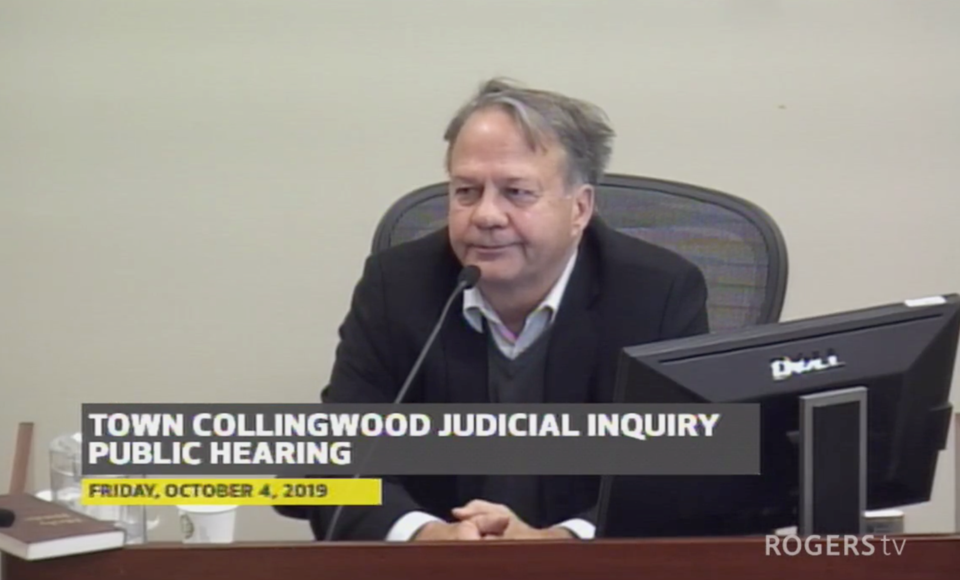An architect hired by the town in 2012 to provide estimates for arena building options told the Collingwood Judicial Inquiry it was unfair the way numbers provided by his firm were manipulated for a staff report on recreation facility estimates.
Richard Dabrus was on the witness stand Friday (Oct. 4) at the Collingwood Judicial Inquiry in his capacity as one of two partners behind WDG Architects, the firm hired by the town first for the Central Park redevelopment planning work and again when council asked staff for options outside of the multi-use recreation facility proposed by the Central Park Steering Committee.
In a memo sent to WDG from Dave McNalty, the town’s purchasing manager, the town asked WDG to “explore the feasibility … of several options” for the Central Park arena.
WDG was not asked to present information about pool building options. The memo was sent July 20, 2012, and set a hard deadline of Aug. 15 for WDG to provide the town with the information for arena building options.
“That’s an extremely short fuse,” said Dabrus on the stand, adding the tight deadline impacted his firm’s ability to provide information to the town. “There was a tone through the entire exercise that was very impatient on the town’s part.”
WDG did provide a report with some cost estimates for both a pre-engineered steel building and a fabric membrane structure. The report was never provided to council, inquiry documents show.
A staff report referenced information provided from WDG for a pre-fabricated steel building, but the numbers presented in the staff report were changed from those presented in WDG’s report.
McNalty testified earlier last week he, under direction from town management, changed the WDG numbers to add a second floor to the arena, doubling the contingency fees, and adding environmental components. He said it was to create an apples-to-apples comparison of the Sprung building budget and a pre-fab steel structure building budget.
Those altered numbers were compared to budget information provided by Sprung - a manufacturer of fabric membrane buildings.
Dabrus said WDG was never asked to include a second-floor mezzanine in the pre-engineered structure, and he suggested the environmental components added to a steel structure option should also have been added to the fabric membrane structure for a more apples-to-apples comparison.
Inquiry counsel Kate McGrann asked Dabrus to look at the numbers provided to the town by Sprung and compare it to the estimate his firm provided on a steel-structure.
She asked if it was a fair comparison included in the staff report, which concluded Sprung was more cost-effective.
“No, I don’t think it’s a fair comparison,” said Dabrus.
He further stated the numbers included in the staff report for second-floor additions to a steel-structure building were “kind of made-up” and the contingencies were “kind of all over the map.”
More than the numbers presented in the report, Dabrus said the mention of Sprung specifically in a cost comparison was “unethical.”
“Architectural firms/engineering design firms get hired by clients to represent client’s interests, so we have to be impartial,” said Dabrus. “If I was asked by the client … is it good practice to specify a particular supplier? I would say no … We’ll provide specifications for a building, but we’re not representing a supplier … that’s a conflict of interest.”
However, the staff report that went to council directly referenced Sprung and included budgets provided by BLT Construction/Sprung for a fabric membrane arena.
“If you had been aware the town was talking to other people about prices on other types of structures, would that have affected or changed the approach you took?” asked McGrann to Dabrus.
“Yes, it would have put the brakes on things,” he responded. “It would have made for a strange playing field because, again, we don’t represent any particular manufacturer. We provide specifications for how buildings should be designed and built.”
The WDG report compared the pre-fabricated steel structure to a generic fabric membrane structure.
Tom Ingersoll was an independent cost consultant working for WDG and concluded the overall savings by using a fabric structure over a pre-engineered steel structure would be in the range of $450,000 to $550,000.
Dabrus testified he disagreed with Ingersoll’s conclusion the fabric membrane structure was cheaper than a pre-engineered enclosure.
“But he was hired as the costing expert, so we kept it,” said Dabrus.
The staff report that went to council on Aug. 27, 2012 showed the difference between the pre-fab steel building and the fabric membrane structure was $3.1 million to $4.1 million. At that meeting, council decided to pursue two insulated fabric membrane structures for the arena and pool. Sprung and BLT construction were hired to supply and construct both buildings in a sole-sourced contract.
The Collingwood Judicial Inquiry was called in February 2018, and there have been public hearings since April, 2019. The first phase of the inquiry was focused on the 50 per cent share sale of Collus in 2012 to PowerStream. Hearings for that phase wrapped up in June.
This current, second phase of the inquiry deals with the allocation of sale proceeds toward building two fabric membrane recreation buildings - a pool and an arena.
Dabrus will return to the witness stand on Wednesday for cross-examination by inquiry participants. Currently, former deputy mayor Rick Lloyd is on the witness stand.
The inquiry hearings continue today, tomorrow, and Wednesday this week at the town hall council chambers.


